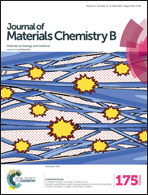Mn-complex modified NaDyF4:Yb@NaLuF4:Yb,Er@polydopamine core–shell nanocomposites for multifunctional imaging-guided photothermal therapy†
Abstract
Upconversion nanoparticles (UCNPs) have been used as building blocks in the construction of multimodal contrast agents for theranostics, that is, the combination of diagnostics and therapies. Upconversion luminescence (UCL) imaging is widely used for cell and tissue imaging while magnetic resonance imaging (MRI) is well-suited for in vivo imaging. Photothermal therapy (PTT) using (near-infrared) NIR laser radiation constitutes a minimally invasive alternative to the conventional surgical treatment of cancer. As such, multifunctional Mn-complex modified NaDyF4:Yb@NaLuF4:Yb,Er@polydopamine (PDA) nanocomposites (Dy@Lu@PDA–Mn) were synthesized, which was based on the fact that Yb3+ and Er3+ induce UCL, Dy3+ and Mn2+ interferes with T2 and T1 in MRI, and PDA strongly absorbs in the NIR region for PTT. Through tri-modal UCL, T1-, T2-weighted MRI guiding, an outstanding photothermal therapeutic efficacy with tumour elimination was obtained in a mice breast cancer model, by injection of Dy@Lu@PDA–Mn upon laser irradiation. A strategy for multimodal imaging-guided PTT was formulated and the potential of multifunctional nanostructures for use in cancer theranostics was demonstrated.


 Please wait while we load your content...
Please wait while we load your content...